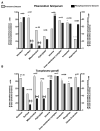The phosphoproteomes of Plasmodium falciparum and Toxoplasma gondii reveal unusual adaptations within and beyond the parasites' boundaries
- PMID: 22018241
- PMCID: PMC3254672
- DOI: 10.1016/j.chom.2011.09.004
The phosphoproteomes of Plasmodium falciparum and Toxoplasma gondii reveal unusual adaptations within and beyond the parasites' boundaries
Abstract
Plasmodium falciparum and Toxoplasma gondii are obligate intracellular apicomplexan parasites that rapidly invade and extensively modify host cells. Protein phosphorylation is one mechanism by which these parasites can control such processes. Here we present a phosphoproteome analysis of peptides enriched from schizont stage P. falciparum and T. gondii tachyzoites that are either "intracellular" or purified away from host material. Using liquid chromatography-tandem mass spectrometry, we identified over 5,000 and 10,000 previously unknown phosphorylation sites in P. falciparum and T. gondii, respectively, revealing that protein phosphorylation is an extensively used regulation mechanism both within and beyond parasite boundaries. Unexpectedly, both parasites have phosphorylated tyrosines, and P. falciparum has unusual phosphorylation motifs that are apparently shaped by its A:T-rich genome. This data set provides important information on the role of phosphorylation in the host-pathogen interaction and clues to the evolutionary forces operating on protein phosphorylation motifs in both parasites.
Copyright © 2011 Elsevier Inc. All rights reserved.
Figures




References
-
- Abe K, Aoyagi A, Saito H. Sustained phosphorylation of mitogen-activated protein kinase is required for basic fibroblast growth factor-mediated axonal branch formation in cultured rat hippocampal neurons. Neurochem Int. 2001;38:309–315. - PubMed
-
- Beausoleil SA, Villen J, Gerber SA, Rush J, Gygi SP. A probability-based approach for high-throughput protein phosphorylation analysis and site localization. Nat Biotechnol. 2006;24:1285–1292. - PubMed
-
- Bodenmiller B, Mueller LN, Mueller M, Domon B, Aebersold R. Reproducible isolation of distinct, overlapping segments of the phosphoproteome. Nature methods. 2007;4:231–237. - PubMed
-
- Boothroyd JC, Dubremetz JF. Kiss and spit: the dual roles of Toxoplasma rhoptries. Nature reviews. 2008;6:79–88. - PubMed
Publication types
MeSH terms
Substances
Grants and funding
LinkOut - more resources
Full Text Sources
Other Literature Sources
Molecular Biology Databases

